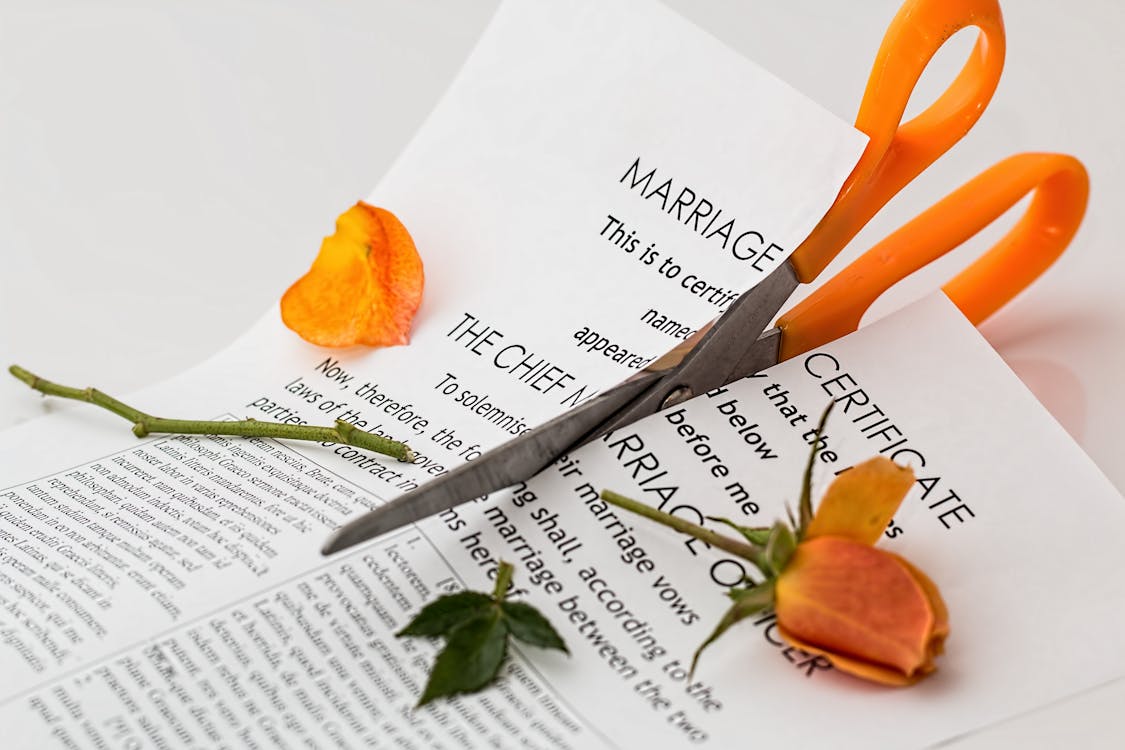Why I Love Divorce (and You Should, Too)
Before
anyone assumes I’m a man-loathing, unromantic based on what I thought was a
mildly amusing title, I would like to preface this piece by stating I do hope
to be married someday. One day, I want to look at someone and think “gee, I
could wake up next to you forever”. It’s not even a question. I’m a hopeless
romantic at heart, and I look forward to finding the man or woman I get to make
happy (and sometimes miserable) for the rest of my life. This article has
nothing to do with hating marriage, and everything to do with recognising
divorce as an important component of women’s liberation.

Image Description: Photo of a marriage certificate being cut in half by a pair of orange scissors. There is also an orange rose laid out on the marriage certificate, which is cut in half as well. The head of the rose is on the right half and the stem is on the left. A loose leaf is also on the right, while a loose petal is on the left. The certificate is set against a plain white table.
Our
divorce rates are actually lower today than they were 30-40 years ago when
divorce rates reached their peak. This increase can easily be attributed to the
introduction of the Family Law Act 1975,
(FLA) which allowed separated couples access to what’s known as a No-Fault
Divorce. As the name indicates, a No-Fault Divorce means a couple can end their
marriage without having to demonstrate how the other party was at fault for the
breakdown of the relationship. This act repealed the Matrimonial Causes Act 1961, which required a spouse to be found
either guilty or innocent of crimes such as adultery, cruelty, and desertion.
If one failed to adequately prove their case, the judge would decline the
request for a divorce. If
a spouse was successful in proving the other to be at fault, the consequences
could strip the person at fault of custody rights and financial security.
There were
many benefits to the introduction of such laws. A great deal of those benefits further
empowered women. They made it easier to leave an abusive marriage, as women no
longer had to compile evidence or seek permission from the very partner that
was a danger to their safety. It also saw a decline in women taking their own
lives, with a noted 20% decrease in female suicide rates following the
introduction of the FLA. While statistics for domestic violence and intimate
femicide did not exist in Australia in the 1970s, the introduction of similar
laws in the USA showed a drastic reduction in reported rates of domestic
violence.
The
children of separated couples also benefited from these laws, since they no
longer had to witness their parents tearing each other to shreds to establish
legal grounds for divorce. That’s not to say this kind of violence doesn’t
still happen, but it’s most likely not occurring as a result of trying to have
a divorce granted. The compulsion to lie or fabricate evidence to establish
fault was also diminished, as there was no longer incentive to do so outside of
being a generally unpleasant human being.
That’s not
to say the FLA isn’t without its share of faults. One particularly concerning
element of the FLA reads as follows:
An application for a
divorce order in relation to a marriage shall not, without the leave of the
court granted under subsection (1C), be filed within the period of 2 years
after the date of the marriage unless there is filed with the application a
certificate:
(a) stating that the parties to the marriage have considered a
reconciliation with the assistance of a specified person, who is:
(i) a family counsellor; or
(ii) if the court is the Family Court, the Federal Circuit Court of
Australia or the Family Court of a State—an individual or an organisation
nominated for the parties by a family consultant; or
(iii) if the court is not the Family Court, the Federal Circuit Court of
Australia or the Family Court of a State—an individual or an organisation
nominated for the parties by an appropriately qualified officer of the court;
and
(b) signed by that person or on behalf of that organisation, as the case
may be.
In simple
terms, if a couple seeks divorce less than 2 years after their marriage, they
are required to show they have attempted to make their marriage work by
consulting a family counsellor. While
this is not necessarily a bad thing in all cases, there are instances in which
this requirement can be emotionally damaging for the parties involved.

Image Description: Close up photo of the torso of a person wearing a wedding dress with lace embellishments. The person wearing the dress is making a heart out of their hands just in front of their belly button. Another person, wearing a black tux, has their arms wrapped around the person with the wedding dress's waist. They are making a bigger heart with their hands around the other person's hands. The background is mostly white with a strip of blurred, green grass on the right.
For
instance, a friend of mine split from her husband approximately five months
after they married. Her reasons for this seperation were hardly frivolous.
Aside from him being a generally toxic and emotionally abusive presence in her
life, three days after they got married, he demanded she consent to an open
marriage. He also declared he would not compromise, and that her choices were
to either go along with this proposed new lifestyle or leave. This is not to
say an open marriage is a bad thing, either. However, these were not the terms my
friend signed up for when she agreed to marry him.
The
obligations this section of the FLA placed on my friend meant she would either
have to put work into salvaging a relationship she had never wanted to end in
the first place, or remain married to him until the required period of time elapsed.
The very thought of going through the counselling process caused her such
distress and anxiety she ended up making no moves to file for divorce until the
two years had ended.
Despite certain
flaws of the FLA, it is clear the law as a whole represents a positive step
towards the reduction of prolonged domestic violence scenarios. It is further
evidence of our society’s movement towards gender equality. That said, even though increased accessibility to divorce has many observable advantages, the
nature of such laws has come into question for a variety of reasons.
An article
published on popular online feminist blog Jezebel in 2010, argued such laws had
the potential to financially disadvantage women in the USA. It suggested these
laws were particularly harmful to those with lower levels of education, lower
earning ability, or women who had not been in the workforce for some time due
to their spouse being the sole income earner. The author, Katy Kelleher, points
out that without the ability to establish fault in divorce, the potential
exists for the woman to lose access to payments that were previously available
to her.
The usual arguments
that such laws violate the sanctity of marriage (with no word on how domestic
violence posits a similar violation of the marriage agreement) are also
prominent in such discussions, though the value of their input is questionable.
The core of this argument seems to be the institution of marriage is crumbling
under ever-increasing rates of divorce.

Image Description: Photo of a blank divorce certificate in a black frame. The words "Certificate of Divorce" are written in fancy, cursive writing along the top. It is lying on a plain, white table. To the right of the divorce certificate is a black pen with gold embellishments and a notary stamp. They are lying on the table, angled towards the certificate.
This
outrage is ultimately unfounded. The reality of the situation is quite the
opposite. After the initial spike in divorce rates following the introduction
of the FLA, instances of divorce in Australia gradually reduced. The peak of
Australia’s rates of divorce was in 1976, at 4.9 per thousand. In comparison, between
2007-2011 the rate per 1000 hovered around 2.2 and 2.3. When comparing
Australia’s rates of divorce to other countries, Australia doesn’t make the list
of top 10 countries with the highest divorce rate. We’re not even in the top
20.
The number
of couples who choose to get married hasn’t declined in line with divorce either.
If anything, marriage rates have been steadily increasing for the last decade.
Interestingly, the age at which people are getting married is also increasing.
Perhaps it’s just people are taking their time and making smarter choices?
Though we
are generally aware of the inequalities our mothers suffered, it’s difficult
for the younger among us to fully comprehend what it is like to not have the
legal right to equal pay (the legislation for which was passed in 1969), access
to safe refuge from an abusive spouse (Australia’s first women’s shelter was
opened in 1974or even a government body chronicling instances of domestic
violence. These are rights we have thankfully never had to go without.
But the
reality is our mothers, grandmothers and the generations before them often
stayed in bad marriages because they had no other options. If they left, they
risked being alienated from their social networks, their children’s
reputations, and the ability to financially take care of themselves.
I remember
asking my great grandmother what my great grandfather was like. He died before
I was born, and nobody would ever talk about him. She never said a word beyond the
fact that his mother hated her and thought her son could do better. So, I tried
asking my grandfather what his father was like. He didn’t say anything beyond
“he was my dad”. It was only after my great-grandmother passed away that I
learned how she had suffered at his hand. I found myself wondering why nobody
helped her and instead held their silence, despite knowing what kind of person he
was. But that’s the thing, isn’t it? I have the luxury of asking these
questions, the luxury of wondering how my great-grandmother endured staying
with someone she so desperately feared and despised.
So, I
suppose the main reason I love divorce is that, to me, it represents women
gaining access to autonomy over their lives. In conjunction with ongoing steps
to bolster women’s earning ability, these divorce laws allow women the freedom to
live their own life without having to attach themselves financially to a suitable
gentleman, and later realise he is a monster.

Image Description: Photo of a black, heart-shaped lock attached to a thick, metal wire. The lock has "love" printed in the middle in white, bold, cursive writing. The background is blurred out. It is mostly yellow with some black shapes in the middle.
I will
openly acknowledge lasting relationships take work. They require compromise, humility, and acceptance. These attributes are absolutely ones we all should be willing
to offer our partners. I do not believe that means one should be obligated to
withstand a hell inflicted on them by their spouse. In my opinion, easier
access to divorce is one of the biggest tools women have added to their arsenal
to empower themselves in the last century.
By: Roxie Gray
Sources:
Disclaimer: The views expressed in this piece do not necessarily reflect
the views of the Sydney Feminists. Our Blogger and Tumblr serve as platforms
for a diverse array of women to put forth their ideas and explore topics. To
learn more about the philosophy behind TSF’s Blogger/ Tumblr, please read our
statement here: https://www.sydneyfeminists.org/a



“My name is Georgina; I had a big problem with my partner for 6 years. One day I heard my sister praising and thanking ( templeofanswer@hotmail . co . uk ) for the job well done. I called them to bring back my husband then Dr. Obodo performed his miracle and in just a day my husband came back to me and we are now happily married. If you want to change your life he is the right person to contact.phone/whatsap; +234 8155 42548-1 ,
ReplyDeleteThanks.” – Georgina – Sydney, Australia.
I still remember the pain I felt when my husband left me — it was one of the hardest moments of my life. But thanks to Dr. Agbazara’s help, my husband returned to me within just two days. I’m deeply grateful for his support, and we’re now happily together and expecting our first child. If you’re struggling with marital or personal issues, I truly recommend reaching out to Agbazara Temple at ( agbazara [at] gmail [dot] com ). I personally experienced the power of his spiritual guidance and healing.
DeleteI was impressed by the level of detail and the quality of the information presented in this article. It provides a comprehensive topic overview and addresses the key issues and challenges. Thank you for sharing your knowledge and expertise about divorce law services
ReplyDeleteIf you're going through a divorce, don't make the mistake of thinking you can handle it on your own. A expert divorce Lawyer can provide invaluable assistance in protecting your rights and achieving a fair outcome.
ReplyDeleteFantastic read! Understanding divorce laws can be overwhelming, but this blog explains everything in a clear and simple way. Very helpful for those seeking legal guidance.
ReplyDeleteBTD Lawyers is one of the leading Divorce Lawyer in Adelaide. Our clients are guided by comprehensive legal advice from our skilled and dedicated lawyers.
Very informative and well-written blog! It really helps readers understand what to expect when dealing with divorce proceedings. Keep sharing such useful content.
ReplyDeleteMatthew Mitchell Solicitors is a leading law firm renowned for having the best Divorce Lawyer in Adelaide. Our highly experienced team of criminal lawyers in Adelaide is dedicated to providing strong, strategic legal representation for individuals facing criminal charges. With deep knowledge of the criminal legal system and years of proven success, we offer sound advice and powerful advocacy tailored to each client’s unique situation.
I still remember the pain I felt when my husband left me — it was one of the hardest moments of my life. But thanks to Dr. Agbazara’s help, my husband returned to me within just two days. I’m deeply grateful for his support, and we’re now happily together and expecting our first child. If you’re struggling with marital or personal issues, I truly recommend reaching out to Agbazara Temple at ( agbazara [at] gmail [dot] com ). I personally experienced the power of his spiritual guidance and healing.
ReplyDelete